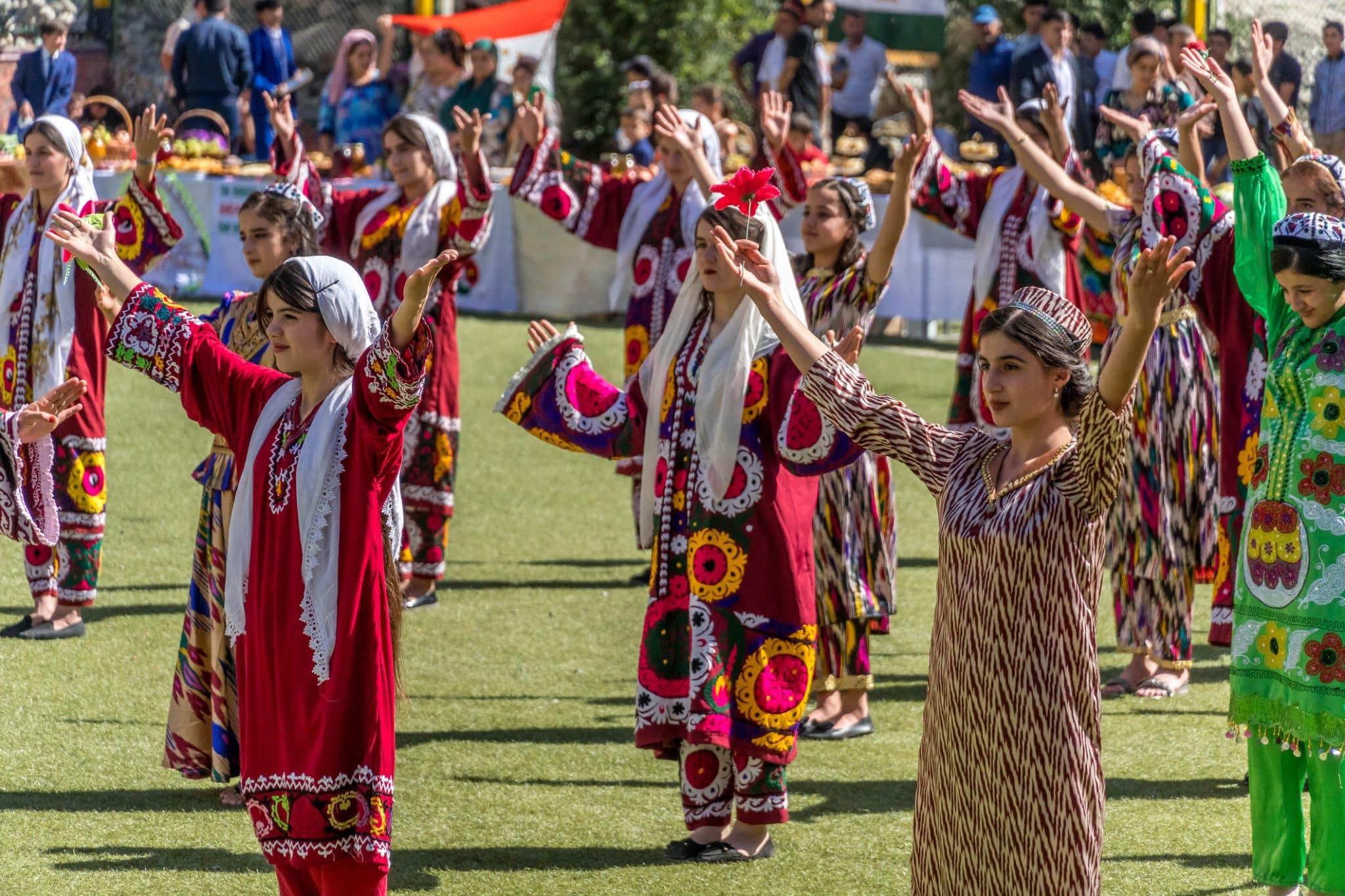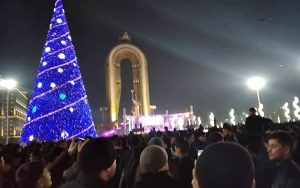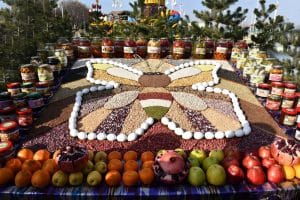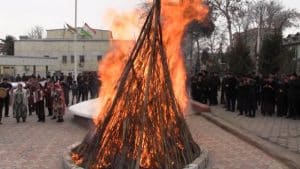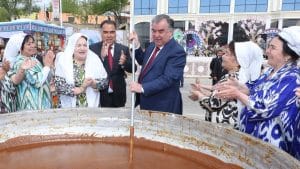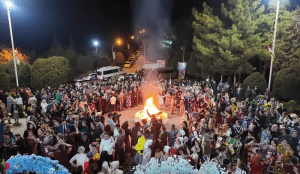Tajikistan’s holiday calendar is a vibrant reflection of the modern country. These holidays blend ancient Persian traditions and Islamic observances with Soviet legacies and contemporary patriotism. Celebrations of unity run deep in this calendar, both as a reflection of shared labor and support in ancient rural life to a healing process as country recovers from a post-Soviet civil war still fresh in the national memory.
Tajik holidays are also reflections of official influence and geography. Many governments, including Persian, Soviet, and the modern state, have tried to influence what holidays are celebrated and how they are celebrated – with varying levels of success. Tajikistan’s unique geography has also meant that its Gorno-Badakhshan Autonomous Province (GBAO) has long been partially isolated from the rest of the state, and has many of its own holidays to celebrate.
Days Off
Long Weekends and Extra Days Off by Semester for 2026
| Spring | Summer | Fall | Winter |
| March 8-9, 20-24 May 1, 9-11,27 |
June 27, 29 | September 9 November 6, 24 |
January 1 February 23 |
New Year’s Day
In Tajik: Соли нав
January 1, 2026
(day off: January 1)
The New Year celebration was introduced under the Soviets. Most elements are adopted from Russian/Soviet traditions, with some localization. In Dushanbe and other urban centers, you’ll see glittering fir trees lining main squares, concerts, and children’s performances. Some people celebrate in local clubs and public places, but the majority celebrate with family and friends. Homes sometimes have a decorated tree. Children recite poems for and, in exchange, receive gifts from Boboi Barfin (Santa Claus), a mythical figure whose name translates as “Grandfather Snowman.” The president makes a short, televised speech to discuss past year’s events and new year’s plans and hopes.
Aside from these borrowed traditions, the food remains largely local: plates of osh (known elsewhere as plov) with green tea, fresh salads, and sweets like chak-chak.
New Year is a somewhat controversial holiday in Tajikistan. State-sponsored celebrations are grand, much as they were under the USSR. However, the holiday is dismissed by some, mostly in rural areas, as a borrowed tradition. Older generations remember that the Soviet’s mandated secular celebrations were coupled with bans on Islamic holidays. The New Year, for instance, effectively replaced Laylat al-Raghaib, which kicked off the three Muslim holy months leading to Ramazan. It was known as a day when prayers had the best chance of being answered.
Some view New Year as conflicting with local values and prefer to focus on holidays rooted in Tajik history and Islamic faith. Others, particularly younger urban residents, see it as a welcome day off—a chance to rest, exchange gifts, visit friends and family, or travel to mountain resorts, where ski lifts run on holiday schedules.
Sada Festival
In Tajik: Сада
January 30, 2026
(Not a day off)
Sada is an ancient Persian fire festival, rooted in Zoroastrian agricultural traditions. Celebrating the coming return of warmth and light and commemorating King Hushang’s mystical discovery of fire, its name comes from the word “sad,” which still means “one hundred” in Tajik, and is believed to refer to the 50 days and 50 nights that separate Sada from the great festival of Navruz. Sada, one of the coldest nights of winter, is sometimes referred to as “shabe gazanda” (the biting night).
In the evening, families gather kindling, dry grasses, and sometimes even old household items to build low, crackling fires. People jump over the bonfires, symbolically purifying themselves from the evils of winter. Family and friends will then gather around a “dastarkhan” (a tablecloth spread on the floor) for a shared dinner.
Other traditions associated with the day include stories told by elders, children reciting poems about light and renewal, and women preparing simple sweets made of honey and nuts. These treats are seen as symbolic gifts to the fire spirits.
Sada has persisted thanks to communal memory, although mostly in rural areas. In has persisted despite resistance from the Soviets and some Islamic sources. A handful of cultural NGOs now sponsor related events in Tajikistan with folk performances, aiming to reconnect younger generations with ancestral traditions. Sada, about the battle of flame against frost, is also a story of resilience and renewal.
Batayom
In Tajik: Батаём
February 18, 2026
(Not a day off)
Batayom is a regional festival celebrated in the Gorno-Badakhshan Autonomous Province (GBAO) to mark the gradual retreat of winter. High mountains isolate the region and it has developed district languages, holidays, and other cultural elements.

In the high mountains, winters can be especially severe. Over generations, communities learned to read the first signs of spring: a warmer wind, the first trickle of meltwater, or the singing of local birds. Batayom is all about these observations and celebrating the community essential to surviving a harsh environment.
The name “Batayom” comes from “Bat,” a thick dish made from wheat flour, oil, milk, and sugar cooked slowly over a fire. The word’s second part, “ayom,” means “celebration.” Bat is traditionally eaten from large, shared bowls.
Story telling by elders, folk dances and rubob (a traditional musical instrument) performances by young people round out the day. Batayom is not a public holiday but remains vital for GBAO’s cultural identity and the generational passage of its collective environmental and moral wisdom.
In the past, the day was also marked by gathering clay or chalk to smear over walls and ceilings, brightening interiors that had been darkened by the winter’s soot. Modern housing and heating, however, has meant that, while this tradition is remembered, it is no longer practiced.
Armed Forces Day
In Tajik: Рӯзи артиши миллӣ
February 23, 2026
(day off: February 23)
Armed Forces Day commemorates the establishment of the Tajik National Army in 1992.
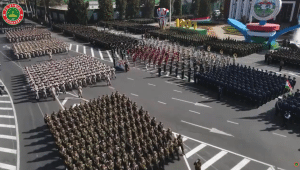
ISTIKLOL TV.
The main observance is held in Dushanbe’s central Dousti Square and Victory Park, where uniformed soldiers march, officials lay wreaths at monuments to fallen servicemen, and the President or Defense Minister delivers a speech emphasizing loyalty, sacrifice, and the army’s role in safeguarding sovereignty. Local administrations also host ceremonies for retired officers. Veterans receive medals, certificates, and flowers from representatives of the Ministry of Defense. Media outlets run profiles of soldiers and recount stories of heroic wartime experiences.
The holiday is also a general celebration of men. In homes, schools, and offices, women and children present small gifts, flowers, or chocolates to male family members, teachers, and colleagues. It’s a gesture of respect and gratitude, reinforcing the idea that every citizen plays a part in national defense. From early grades through universities, assemblies focus students on civic values with patriotic songs, military oath recitations, and short plays about military history.
Interestingly, the new army shares its birthday with the old Soviet army, and so the holiday falls on what used to be the USSR’s Defenders of the Fatherland Day. Thus, the holiday acknowledges shared history with the other former Soviet States that also continue to celebrate their militaries on this day.
International Women’s Day / Mother’s Day
In Tajik: Рӯзи модарон / Рӯзи байналмилалии занон
March 8, 2026
(days off: March 8-9)
International Women’s Day, also known as Mother’s Day in Tajikistan, is another legacy of Soviet-era policy that remains deeply ingrained in the national calendar. Originally intended to celebrate the advancement of women’s rights, the holiday is now most popularly understood as a broad celebration of women’s contributions at home, school, and work. Flowers and sweets are offered to mothers, daughters, teachers, and colleagues. Town squares and cultural centers host short concerts featuring local singers and dancers. In some regions, women’s associations organize roundtable discussions on women’s health, education, and entrepreneurship.
Despite occasional critiques that the holiday’s focus on flowers and gifts overshadows substantive discussions of gender issues, most Tajiks value it as a moment of collective appreciation of the role of women in families and society.
Ostonnihtayd
In Tajik: Остоннихтайд
Second week of March
(Not a day off)
Celebrated mostly in rural areas of the Gorno-Badakhshan Autonomous Province GBAO just before Navruz, Ostonnihtayd marks the start of spring plowing and the awakening of the earth.
In the past, farmers in Gorno Badakhshan timed their sowing by natural signs like receding snowlines, the clarity of mountain streams, and the first song of migratory birds. At this time villagers bring out oxen or bulls for a ceremonial first furrow and then cook and share a communal meal, usually osh or a soup like shurbo. This is followed by traditional games, wrestling matches, and, in larger villages, live music performances.
Ostonnihtayd reinforces the reciprocal relationship between people, their land, and their community. By dedicating a moment to collective work and communal sharing, communities affirm that survival in high altitudes relies depends on cooperation, environmental attunement, and respect for ancestral knowledge.
In Tajik: Наврӯз
March 20–24, 2026
(days off: March 20–24)
Navruz, an ancient Zoroastrian celebration of the spring equinox, is arguably the most important holiday in Tajikistan. It marks the triumph of warmth over winter, the start of the new year, and a season of growth and renewal. In Persian mythology, Navruz is also the day Ahura Mazda, the supreme deity of Zoroastrianism, defeats the evil spirit Ahriman.
Banned during the Soviet era, Navruz returned during glasnost and was reinstated as a public holiday in the late 1980s, one of Tajikistan’s first acts as it began asserting greater autonomy. Since independence, it has become a major symbol of cultural pride. The festival lasts four days—all official holidays.
Preparations begin weeks in advance, with families cleaning homes and making repairs. Women and girls cook sumanak, a sweet wheat paste stirred for hours in large cauldrons. With such highly labor-intensive preparation, the dish is almost never made outside the Navruz season and is shared among family and neighbors, symbolizing health and prosperity. It is also part of the Haft Shin or Haft Sin table, which features seven symbolic items beginning with the Persian letter “Sh” or “S.”
Throughout Tajikistan, open-air festivals include folk dancing, concerts, and sports. Volleyball is especially popular, along with traditional games such as buzkashi (a sort of goat-polo), gushtingiri (wrestling), aspdavoni (horse racing), and barrajangi (ram fighting). Children and young adults play tukhmjangak, a game where hard-boiled eggs are tapped against each other—the last egg left uncracked wins.
A wide range of dishes like osh, soups, dried fruits, chak-chak, and halva and are eaten, often at large gatherings. Holiday bazaars spring up and children often recite the poem “Bahor omad” (Spring Came), as they run through the celebration area.
Navruz is today celebrated across the region, mostly in states with a shared heritage under Persian empires. The Tajik government often points out that the festival is part of regional tradition, emphasizing ties to the cultures surrounding it.
In ancient Zoroastrian tradition, Navruz was part of a seven-celebration cycle. The Tajik holidays of Sada, Tirgan, and Mehregan are believed to be descended from those holidays which helped mark the time throughout the year and maintained the agricultural cycle. In Zoroastrian myth, the seven celebrations also celebrated the seven great creations, including plants, bulls, and humans while Navruz specifically celebrated fire and the unification of the seven creations.
Cosmos Day
In Tajik: Рӯзи Космос
April 12, 2026
(Not a day off)
Cosmos Day commemorates Yuri Gagarin’s historic first human spaceflight in 1961—a point of pride for all former Soviet republics, including Tajikistan. The day is marked with educational and cultural events. Planetariums offer public lectures, and schools hold special lessons where students build model rockets or code basic satellite simulations. Science clubs may host stargazing nights and telescope demos. National media airs documentaries on the Soviet space program and highlights Central Asian scientists. The holiday celebrates human discovery and aims to inspire future astronomers, engineers, and explorers.
Labor Day
In Tajik: Рӯзи меҳнат
May 1, 2026
(day off: May 1)
May 1, once a Soviet celebration of workers’ solidarity, remains on the Tajik calendar to honor those who contribute to the country’s development. In cities like Dushanbe and Khujand, parades feature factory teams, farmers, teachers, and civil servants carrying banners. Officials give speeches praising “honest labor” and present awards to top workers. Parks host fairs where artisans sell handwoven carpets and embroidery. Most people, however, celebrate with barbecues or simply by enjoying the spring weather.
Victory Day
In Tajik: Рӯзи Ғалаба
May 9, 2026
(days off: May 9-11)
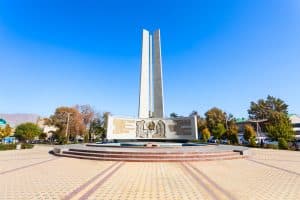
Victory Day marks the Soviet defeat of Nazi Germany in 1945, an event that resonates deeply in Tajikistan’s collective memory. During the Great Patriotic War, Tajikistan lost more than 100 thousand people (around 7% of its population). To mark the date, government and military officials lay wreaths of red carnations and laurels at monuments in Dushanbe’s Victory Park and other memorials across the country. Surviving veterans, wearing their medals, are honored in public ceremonies where the national anthem is followed by wartime songs. Some, like “Victory Day” (“День победы”) are sung in Russian, just as they were under the Soviets, and others are in Tajik, such as “Victory Day” (“Idi Zafar”) and “Song of Loyalty” (“Surudi Sadoqat”).
In preparation for the holiday, schools hold assemblies where students recite poems about courage, display wartime photographs, and sometimes hear firsthand accounts from veteran guests. Television and radio stations broadcast documentaries on Tajik soldiers’ roles in the Great Patriotic War, while local choirs perform Soviet-era anthems in community centers. Families often visit the graves of relatives who fell in battle, leaving flowers and tending to the graves.
Eid al-Fitr
In Tajik: Иди Рамазон
March 20, 2026
Variable Dates
(day off: March 20)
Eid al-Fitr marks the end of Ramadan. Lasting one to three days, the festival is widely and enthusiastically celebrated in Tajikistan.
Ramadan commemorates the month in which the Quran was first revealed to the Prophet Muhammad. To show gratitude for this, Muslims refrain from drinking and eating from sunrise to sunset. They are also commanded to make special efforts to refrain from violence, gossip, swearing, greed and other harmful behaviors. Fasting is seen as a spiritual discipline that helps one to set aside worldly distractions and focus on one’s connection with God.
In preparation for Eid, homes are cleaned and decorated, and people wear new or freshly laundered clothes. The holiday begins with well-attended communal prayers at mosques and open spaces, followed by the giving of zakat al-Fitr—a mandatory donation of food or money to those in need, ensuring that everyone can take part in the celebration.
Families greet each other with “Eid muborak” and feast on osh, shurbo (soup), fresh non (flatbread), shakarob (salad), halva, and chak-chak. Food is often prepared in advance so hosts can focus on welcoming guests. It is customary to visit relatives, neighbors, and the graves of loved ones. Children receive eidiya—small gifts of money—and communities often organize concerts, games, and open tables where all are welcome to share a meal.
The Tajik government has issued guidelines and fines to discourage excessive spending on feasts and gifts for Eid al-Fitr as some people will go so far as to take out loans to mark the occasion lavishly. Children under 18 are barred from attending mosque prayers. State media reminds citizens of these restrictions in the lead up to the event.
Eid al-Fitr remains a vibrant and meaningful celebration across Tajikistan—honoring both religious devotion and deeply rooted cultural traditions of generosity, hospitality, and renewal.
Eid al-Adha
In Tajik: Иди Қурбон
May 27, 2026
Variable Dates
(days off: May 27)
Eid al-Adha commemorates the Prophet Ibrahim’s willingness to sacrifice his son in obedience to God. Celebrations begin with morning prayers and sermons emphasizing faith, sacrifice, and charity. In major cities, worshippers fill mosques, courtyards, and even nearby streets with prayer carpets.
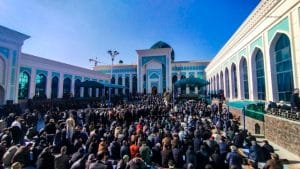
Families who can afford it sacrifice a sheep, goat, cow, or camel, dividing the meat into three parts: one for the household, one for relatives and friends, and one for the poor. Urban families often purchase animals specifically for the holiday and rely on designated slaughter areas staffed by professional butchers. In rural areas, the slaughter typically takes place at home.
In homes across Tajikistan, Eid al-Adha is a time of hospitality and sharing. Traditional foods such as osh, shurbo, halva, roasted meat, and chak-chak are served at communal feasts. Children receive new clothes or small gifts, and charities distribute food to remote areas, reinforcing the holiday’s spirit of sharing.
Due to the scale of celebrations, the Tajik government and religious authorities have sought to regulate aspects of the holiday. Guidelines and fines discourage extravagant animal sacrifices, large gatherings, and expensive banquets. State television emphasizes modesty in spending and preparation. Children under 18 are banned from attending mosque prayers and from the local tradition of going door to door asking for sweets or money. The common practice of visiting cemeteries to pray for the deceased on Eid has also been officially discouraged, with visits now encouraged in the days before the holiday.
National Unity Day
In Tajik: Рӯзи Ваҳдати миллӣ
June 27, 2026
(day off: June 27)
National Unity Day commemorates the 1997 peace agreement that ended Tajikistan’s brutal five-year civil war and set the country on a path toward stability. Second in importance only to Independence Day, it marks the hard-won compromise that allowed former enemies to lay down their arms and rebuild a unified state.
The civil war, which began in 1992, claimed an estimated 50,000 to 150,000 lives and displaced around 1.2 million people. Entire villages were emptied and much of the country destroyed. The conflict pitted the former Communist authorities against the United Tajik Opposition, an alliance of liberal reformers and Islamists. It ended with an agreement to merge military forces and share power in a new government. Elections followed in 1999.
In the spirit of the holiday, the main state-sponsored celebration rotates annually across different regions and is attended by the president and other officials. Leading up to the event, state TV shows the president inaugurating schools, factories, and other infrastructure projects across the country. Each local government also organizes concerts, poetry readings, sports competitions, and food fairs. Television broadcasts include documentaries on the war and coverage of official wreath-laying ceremonies at memorials for those who died fighting it.
National Unity Day is a celebration of peace and unity, but also a reminder of the need for continued development, and a day of mourning for a conflict still fresh in the national memory.
Tirgan
In Tajik: Тиргон
July 3, 2026
(Not a day off)
Tirgan is an ancient Zoroastrian mid-summer festival celebrating water and renewal. The holiday’s mythical origin marks the day that Arash the Archer, the best archer in Persia, shot an arrow from Mount Damavand to determine the border between ancient Persia and Turan. Thus was peace restored between the two states and, after a long drought, both were blessed with rain from Tishtrya, the Zoroastrian divinity of rain.
People are traditionally unified on this day in playful, public water fights. This symbolically washes away the old and welcomes the new. People also celebrate the holiday with traditional dances, poetry recitations, and traditional foods. Children often wear rainbow-colored wristbands which celebrate rain which are then symbolically thrown into a fire after ten days.
Tirgan is being revived with the support of cultural NGOs and the state. Some do not see the point in reviving a long-dead holiday. Others see amusement and cultural tradition in bringing it back.
Independence Day
In Tajik: Рӯзи истиқлолият
September 9, 2026
(day off: September 9)
Independence Day is Tajikistan’s biggest civic holiday. It marks the day that Tajikistan declared its sovereignty from the Soviet Union.
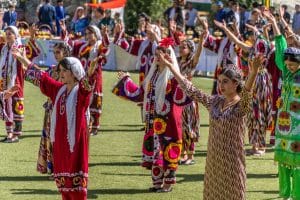
The main celebrations are in Dushanbe, where the morning begins with a military parade along Rudaki Avenue. Ceremonies follow at national monuments, and the President makes a live television broadcast that usually touches on Tajikistan’s struggle for freedom and current plans for economic growth, cultural renewal, and regional peace.
Across the country, cities and towns hold their own regional celebrations, which may include public speeches, awards ceremonies, sports competitions, school performances, and food fairs. Exhibitions highlight local crafts, agricultural products, and youth achievements. Schools and universities often organize special lessons or assemblies about Tajikistan’s history, independence, and cultural heritage. The country is decorated with flags, lights, and banners often featuring quotes from the president or themes of national unity and peace.
Evenings everywhere conclude with fireworks in main squares and smaller gatherings in neighborhood parks. State-supported concerts feature pop singers and traditional musicians alike. Family and friends might celebrate the holiday with outdoor picnics or dinners at home, most often sharing the usual national dish, osh with salads of fresh tomatoes, cucumbers, and herbs.
While the tone of the celebrations is generally festive, Independence Day also carries a political message. Government speeches and media coverage emphasize themes such as national unity, development, peace, and gratitude to the president for maintaining order after the civil war. The day serves not only as a public holiday but also as a demonstration of national identity and political stability in modern Tajikistan.
Mehregan
In Tajik: Меҳргон
October 2, 2026
(Not a day off)
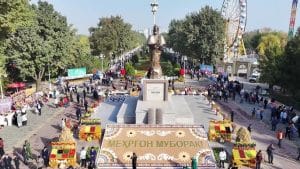
Mehregan is an ancient Persian festival marking the beginning of the harvest. Originally dedicated to Mithra, the Zoroastrian deity of light and love, it was second only to Navruz in importance during the Achaemenid and Sassanid empires. Nobles offered gifts to the king, while families feasted outdoors with fresh fruits, grains, nuts, sweets, and held evening bonfires.
In some rural areas, Mehregan has been preserved. More commonly today, it is reflected in regional harvest fairs that highlight local crops such as apples, honey, melons, and watermelons. These are both sources of national pride and important export goods. Notable events include the Melon and Watermelon Festivals in late August, the Honey Festival in September, and the Apple Festival in October. Each often feature events aimed at agrotourism, professional development, and the agricultural products themselves as well as folk music and crafts. Local governments and cultural NGOs often co-organize the events to preserve cultural heritage and engage younger generations.
Constitution Day
In Tajik: Рӯзи конститутсия
November 6, 2026
(day off: November 6)
Constitution Day honors the November 6, 1994, ratification of Tajikistan’s post-independence constitution. In Dushanbe, the day opens with official readings of key constitutional articles in public squares and cultural centers. Judges, legal scholars, and lawmakers participate in panel discussions, often shown on television. Universities host mock parliamentary sessions where students debate topics ranging from media freedom to environmental protection. Local libraries and community centers organize pertinent exhibitions.
Flag Day
In Tajik: Рӯзи парчами давлатӣ
November 24, 2026
(day off: November 24)
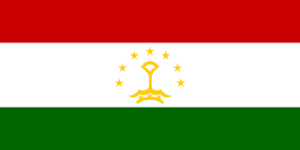
Flag Day commemorates the adoption of Tajikistan’s tricolor flag in 1992. The Tajik flag features a red stripe for freedom and independence, a white stripe for peace and prosperity, and a green stripe for nature and the growing next generation. The central crown and seven stars represent the Tajik people and their seven historical regions. On flag day, in Dushanbe and regional centers, flag-raising ceremonies occur at dawn. Although the holiday lacks large-scale public festivals, it is a central theme at local community centers, schools, and media broadcasts.
You will also like
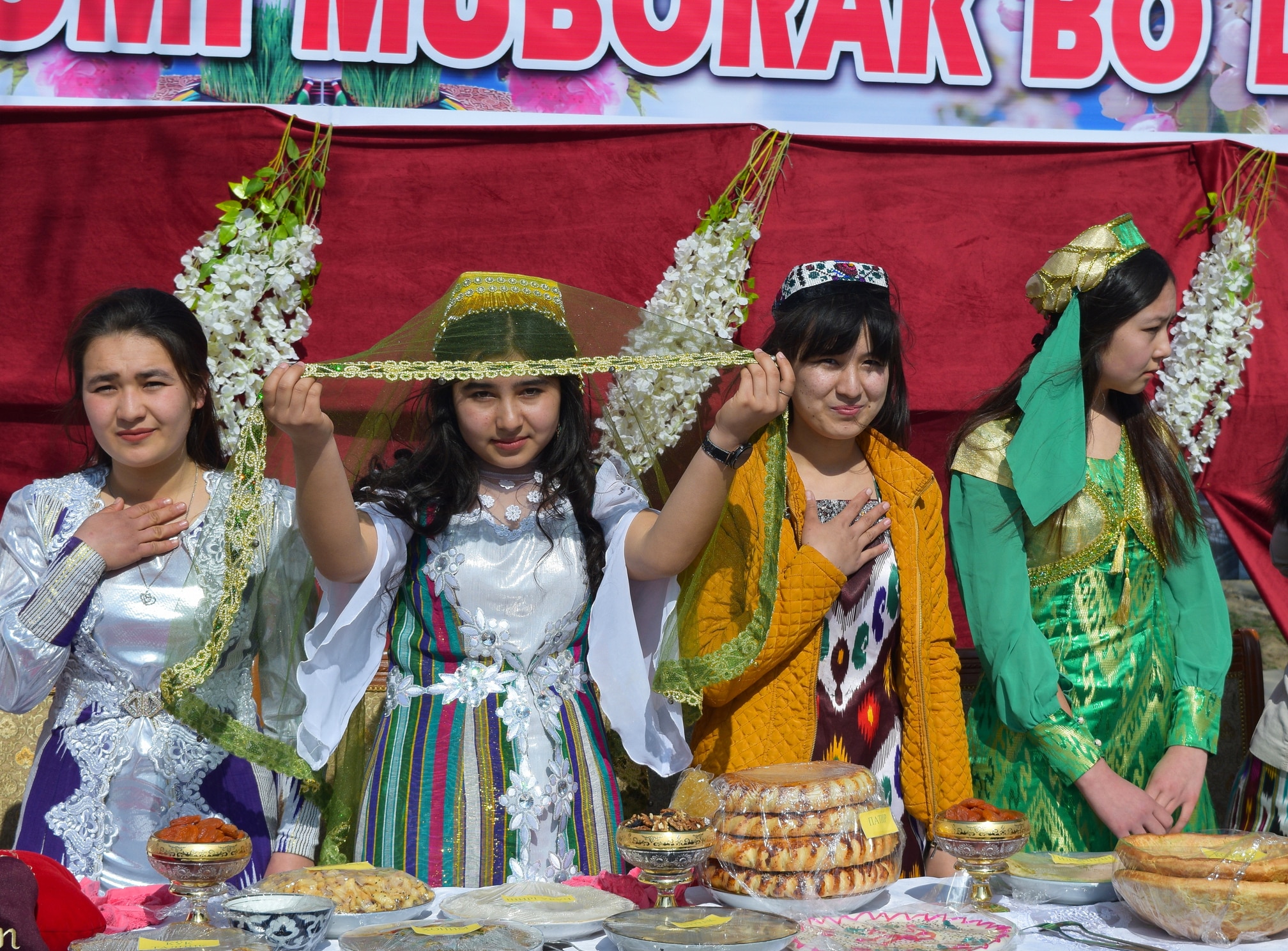
Navruz, Nooruz, Nowruz: The Ancient Spring New Year of Central Asia
Navruz is a spring solstice celebration that marks the beginning of the New Year according to the traditional Persian calendar. It has been a beloved holiday for some 3,000 years, surviving cultural change caused by centuries of tumultuous history. It was once celebrated on the vernal equinox but is now celebrated on the set date […]

Chuchvara, Chuchpara, Tushpara: The Daintier Dumping of Central Asia
Chuchvara is a dumping staple dish in Central Asia, the South Caucasus, and the Middle East. Originally introduced there under the Persian Empire, they are today most associated in Central Asia with Uzbek tradition. However, they are also considered a local national dish throughout the countries of the region. Chuchvara contrast with manti, the other […]
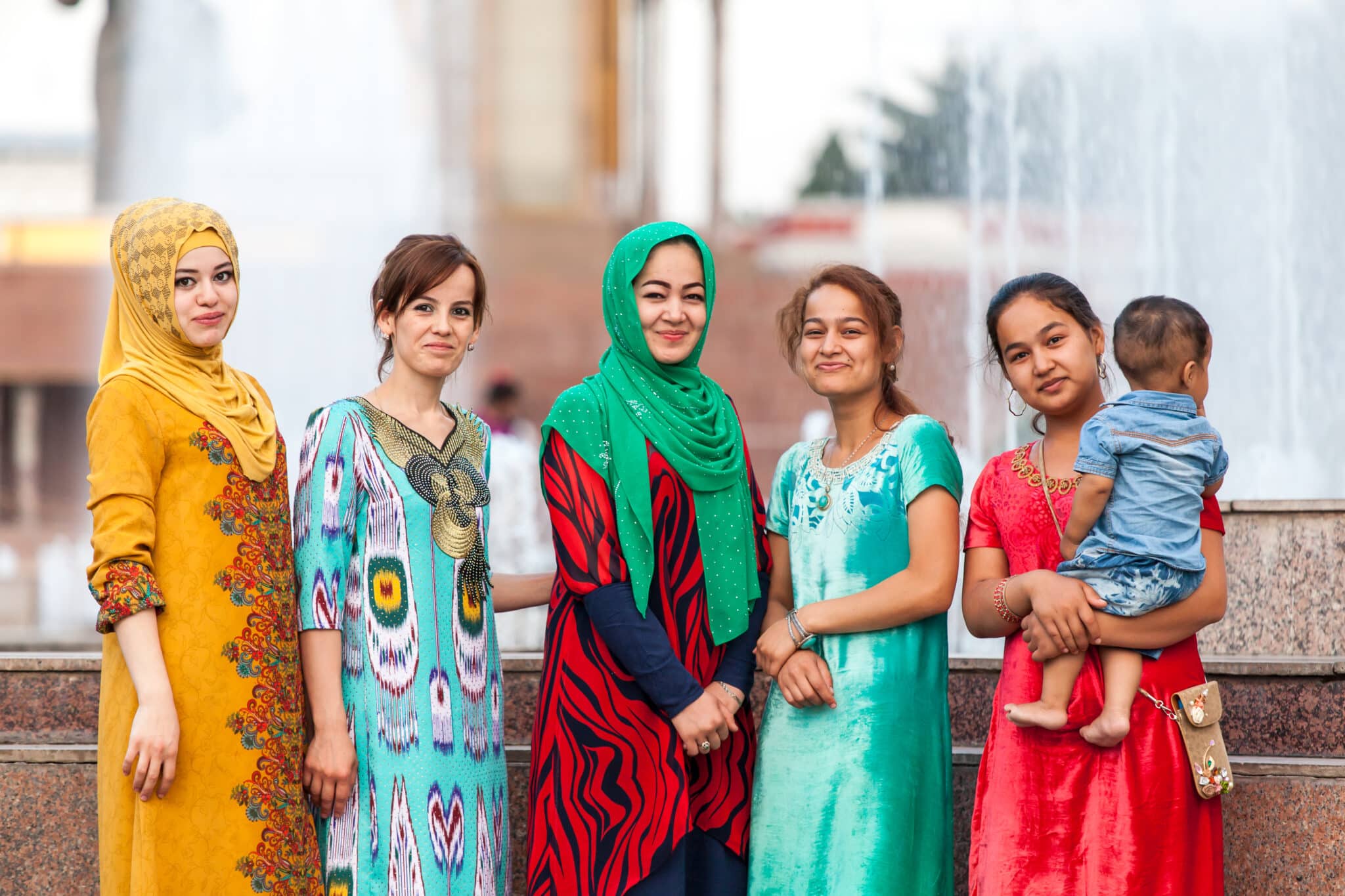
The Talking Tajik Phrasebook
The Talking Phrasebook Series presents useful phrases and words in side-by-side translation and with audio files specifically geared to help students work on listening skills and pronunciation. Below, you will find several useful phrases and words. To the left is the English and to the far right is the Tajik translation. Tajik uses a Cyrillic […]
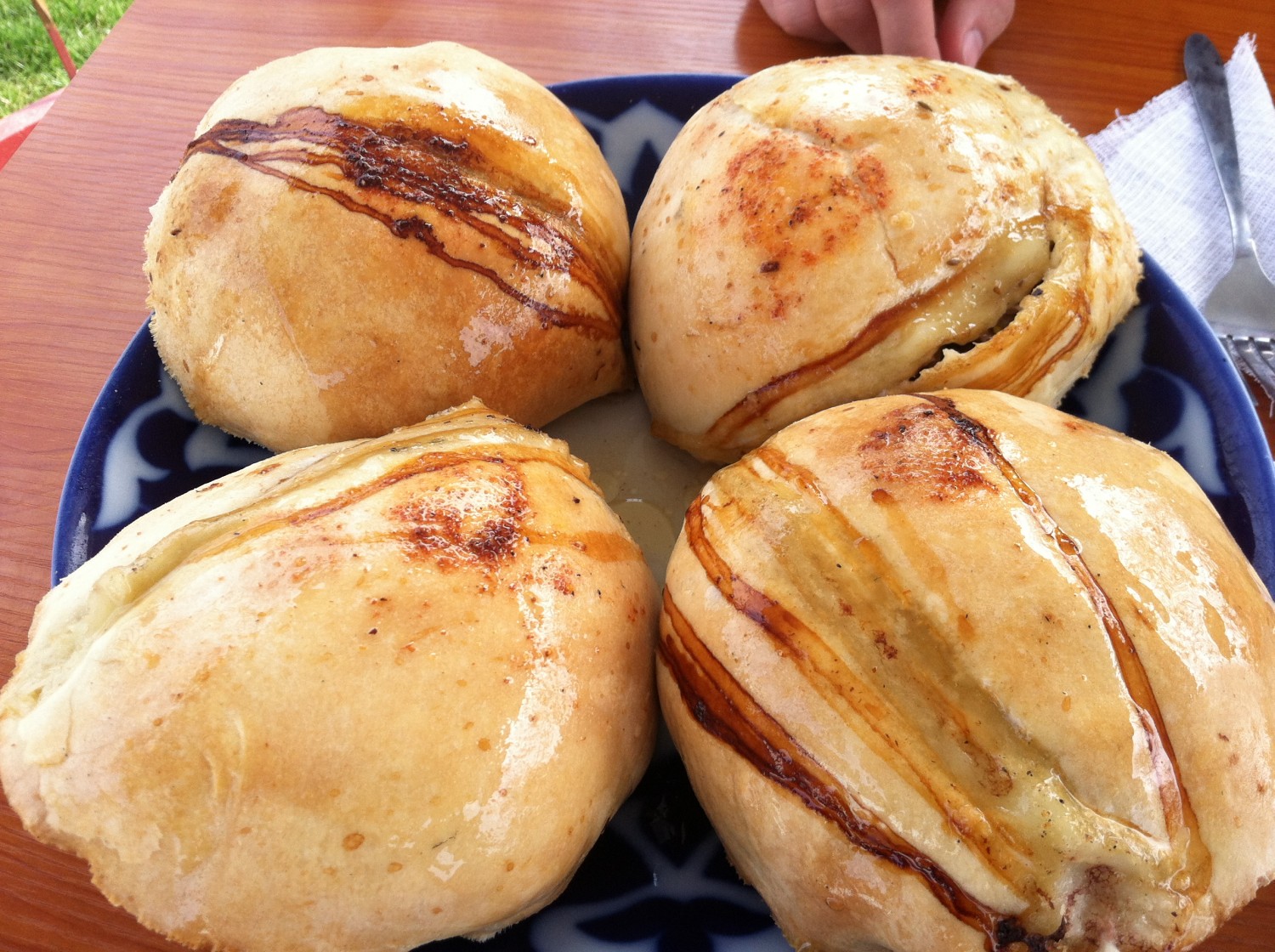
Samsa: A Tasty Pastry of the Silk Road
The samsa (самса) is a meat- or vegetable-filled savory pastry. They are both flaky (слоеная) and crispy (хрустящая). They are enjoyed across the former USSR, where they are most associated with Central Asian cuisine. The samsa originated in the Middle East and spread across the Silk Road (Шелковый путь), reaching Central Asia, India, and Africa. […]
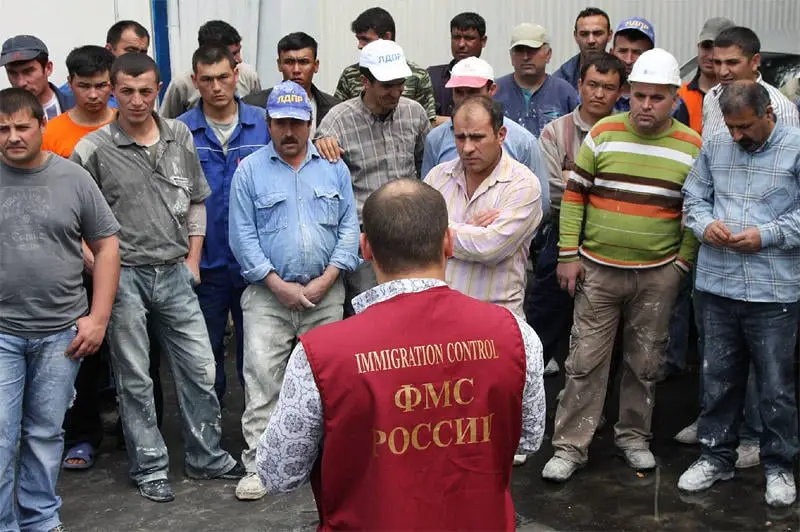
Моя Россия 1: Гости и приезжающиe
The following is lesson 1 of the Моя Россия advanced Russian lesson series. Note that all bold words and phrases have annotation below. Red words and phrases indicate the subject of this blog entry’s grammar lesson. Asterisks indicate slang. Меня зовут Роксана. Мне 23 года, и уже много лет я живу в Москве. Большую часть […]

